The Golden Gate’s elusive bridge song
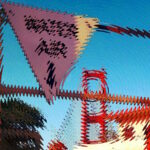
…in which we hear the GGB’s rumored song, but without our usual recording gear in hand…
You may have heard that the Golden Gate Bridge sometimes…sings. And you may have read of the ongoing engineering work to stop it. I’m not sure whether the abatement work is complete, but I can claim to have finally heard the bridge sing its wondrous new song under epic high-wind conditions.
I still lack a quality recording, but I suppose it’s good to have goals. And I have the consolation of some serendipitous, if less-than-stellar, mobile-phone recordings.
Overheard
San Francisco’s big, orange landmark endures salt sea air conditions year-round and lives a life of constant maintenance: painting is continuous, ailing components need replacement, and upgrades—some noticeable, many not—are always in the works. Back in 2020, workers began to refurbish the worn pedestrian safety railings, which had corroded until the water below could be seen through rust holes in the old steel rails and slats. The new rails and slats are lighter and thinner, designed to reduce wind loading. But, once a sufficient number were installed, they exhibited a peculiar feature: under high wind conditions, the bridge acts as an Aeolian harp.
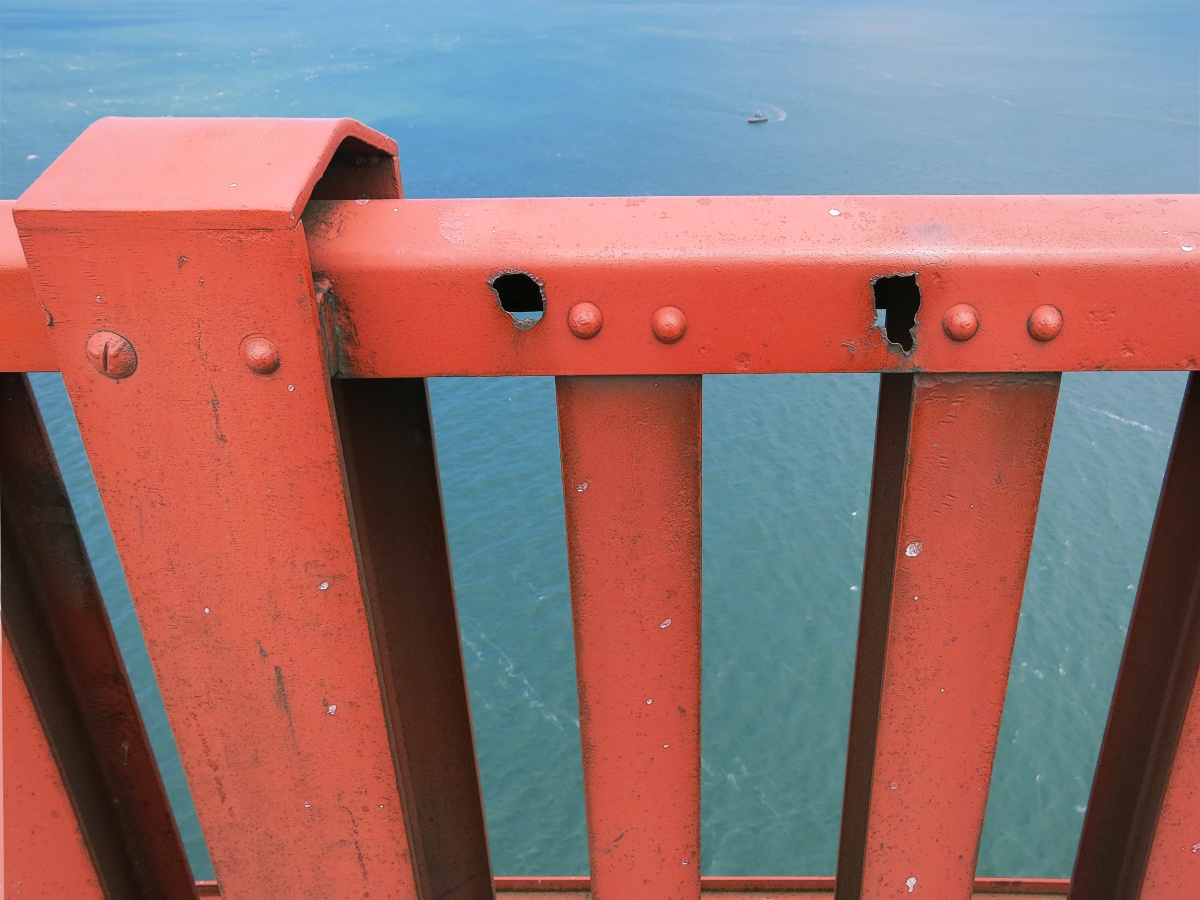
“…there are two distinct sounds that occur under different wind conditions… The first sound is a low-pitched and low-frequency tone (between 280-700Hz) that is present when wind passes perpendicularly to the railing (from the West) at wind speeds of 22mph or more. This lower-frequency tone is often heard furthest away from the Bridge. The second tone present during certain high winds is of a higher pitch and frequency (1.1kHz) and is present when wind passes the railing at a slight angle and with speeds of 27mph or more.”
— Golden Gate Bridge Highway and Transportation District report, 2021
Underrated
The foregoing description, written by a department under fire, predictably avoids terms like “loud” and other pejoratives. But the railing retrofit and its audio side-effects coincided with the early lock-down phase of the COVID-19 pandemic, when Californians were under shelter-at-home orders. San Franciscans had no shortage of things to complain about, but a limited selection of targets—besides the virus itself—to blame for stay-at-home misery.
Enter a VERY LOUD SOUND, persistent and impossible to ignore. Trace its source to a large, slow, and costly civil works project. Let hilarity ensue.
Throughout the COVID pandemic, the local press disparaged the new acoustics to the amusement of readers and, presumably, in agreement with many residents. While brief, usually faint, recordings—along with videos marred by the shouted blather of their selfie recordists—were being uploaded to YouTube, the bridge’s “weird noises,” “eerie hum,” “howl,” and “screeching that sounds like torture” were described in articles with colorful titles like “Why the Golden Gate Bridge Is Now a Giant Orange Wheezing Kazoo” (This from NPR station KQED, no less: see https://www.kqed.org/arts/13881451/the-golden-gate-bridge-sounds-like-a-david-lynch-movie-now while it lasts).
It should be noted that a 22 mph wind speed for “prevailing westerlies” is rather common on the bridge, and can persist through afternoons and evenings in late spring and early summer. Many winter storms bring much higher winds from the west.
Elusive
Clearly, hundreds of thousands of San Franciscans had heard the bridge sing. For visitors, though, timing is everything. I made two forays in late summer of 2020, with insufficient winds both times.
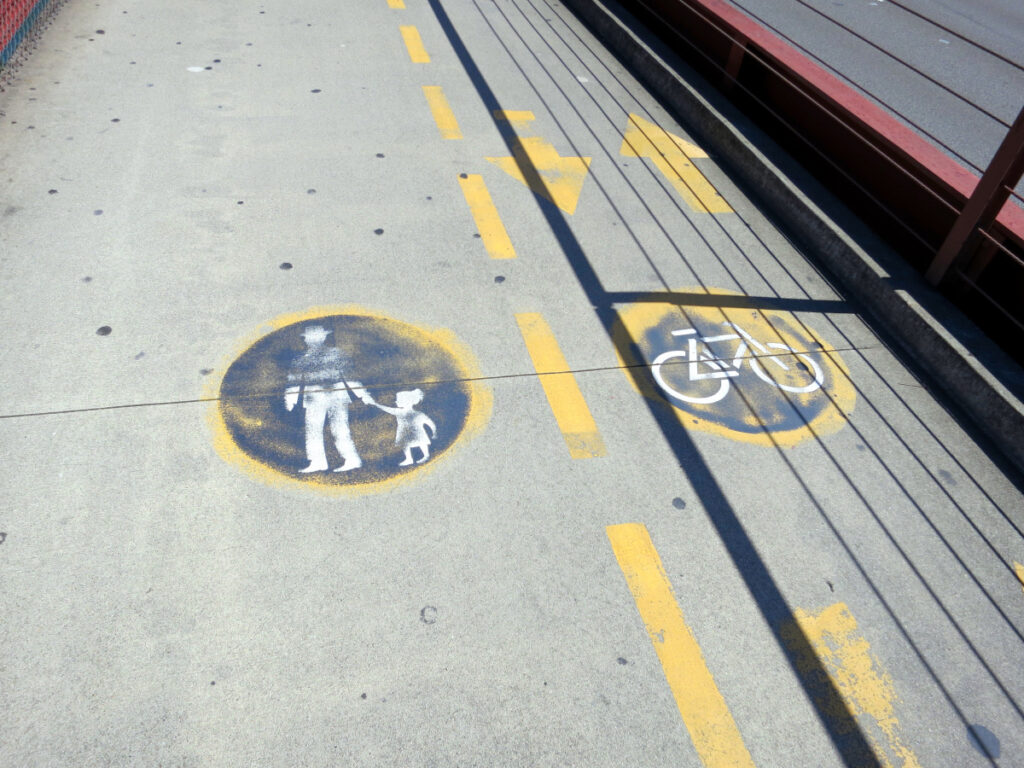
Pandemic restrictions and the intermittent nature of the phenomenon—winds need to be strong enough and from particular directions—limited the recording opportunities. Walking the bridge had become much more dangerous, due to sharing of the east-side pedestrian lanes with cyclists: the west-side railing retrofit work had closed off the dedicated cycling lanes. Add the challenge of recording in high-wind conditions in the first place and it’s not surprising that those internet media uploads were rare and oh-so disappointing.
Two years went by while I made do with second- and third-hand reports. What little I could hear in recordings appearing online suggested a low, pleasant fluting sound dancing through recognizable harmonic intervals. Compared to the urban sonic vandalism of boom-boxes in the 1980s or my suburban neighbors’ gas-powered leaf blowers today? Just as inescapable, perhaps, but arguably much, much more enjoyable.
Gorgeous. Transcendent. Calming. Maybe that’s just me? But I wanted to hear it live.
Endangered
After enduring a year of sarcastic news articles and who knows how many resident complaints, the Golden Gate Bridge District reported it had done “extensive analysis and testing”, responding to the public officially in late 2021:
“The Golden Gate Bridge District (District) is pleased to share a proposed solution to reduce or eliminate the sounds that emanate from the Bridge during high wind events. The District Board of Directors will consider an item at their meeting on December 17, 2021, to approve the solution and associated actions.”
The proposal involved adding aluminum “clips” to the leading and trailing edges of the bridge’s new slats. This would thicken them and alter the airflow pattern enough to reduce the effect.
The District announced the work would cost about $450,000 and be completed by late 2022.
Not yet extinct?
Now, February 21, 2023 happened to be a very blustery day. It also happened to be a vacation day for my wife, and we drove in to the city for a late morning visit to the California Academy of Sciences in Golden Gate Park.
I’d made reservations for a late lunch at Colibri, an old favorite restaurant of ours. Formerly on Geary Avenue near Union Square, they had relocated to the Presidio during the pandemic, and we had yet to try them in the new digs. The new location is a relatively short drive from the park.
Despite some high wind warnings from the weather service, I was not thinking about the Golden Gate Bridge that morning. My focus on lunch didn’t extend to the fact that the Presidio just happens to be at the south terminus of the bridge. And field recording sessions can be lengthy and involved, but this was supposed to be a pleasant, relaxed outing for two. So I had not even considered packing serious recording gear.
At 2:15 that afternoon, we arrived early for our reservation at Colibri in time to find the staff leaving the restaurant. Electrical power had reportedly been out all over the Presidio for hours due to wind-related incidents. Our lunch date was off, and we’d already paid for parking. But as we walked back to the car in disappointment, I realized I was hearing something remarkable…
The bridge was singing.
That’s also when I realized I had nothing along to record with but my cell phone. Since the demise of my unsupported installation of Tape Machine during an unfortunate phone reset the previous year, I had only a voice recording app installed. But it was…something.
So, the first recording was captured about a half mile away as the crow flies, down on the middle ground near the old Presidio Officers’ Club. The second attempt, not much better, was made in the same location but facing a different direction (there’s way too much wind noise, but also some different, distinct drone tones from the bridge):
Since we weren’t getting any lunch anyway, we took an impromptu Presidio tour and drove on up to the bridge visitor center area to park so I could try something closer to the source. The tiny visitor lot was full, but we were able to drive under the roadway and over to the maintenance area behind the old District offices, where parking is (just barely) possible.
Retro amenities
On foot, you can approach the old tollbooth area—no longer manned—from the two-lane underpass and get astonishingly close to the southbound roadway. This recording is mostly road noise and wind, despite a lot of cleanup work in the studio, but it’s here for completeness/perspective:
Past the west (back) side of the large GGB facility building are some interesting sights from back when intrepid motorists carried cash and sometimes needed to top off their radiators. I didn’t test the pay phone, but suspect it may still function. And there really is an air pump around the corner.
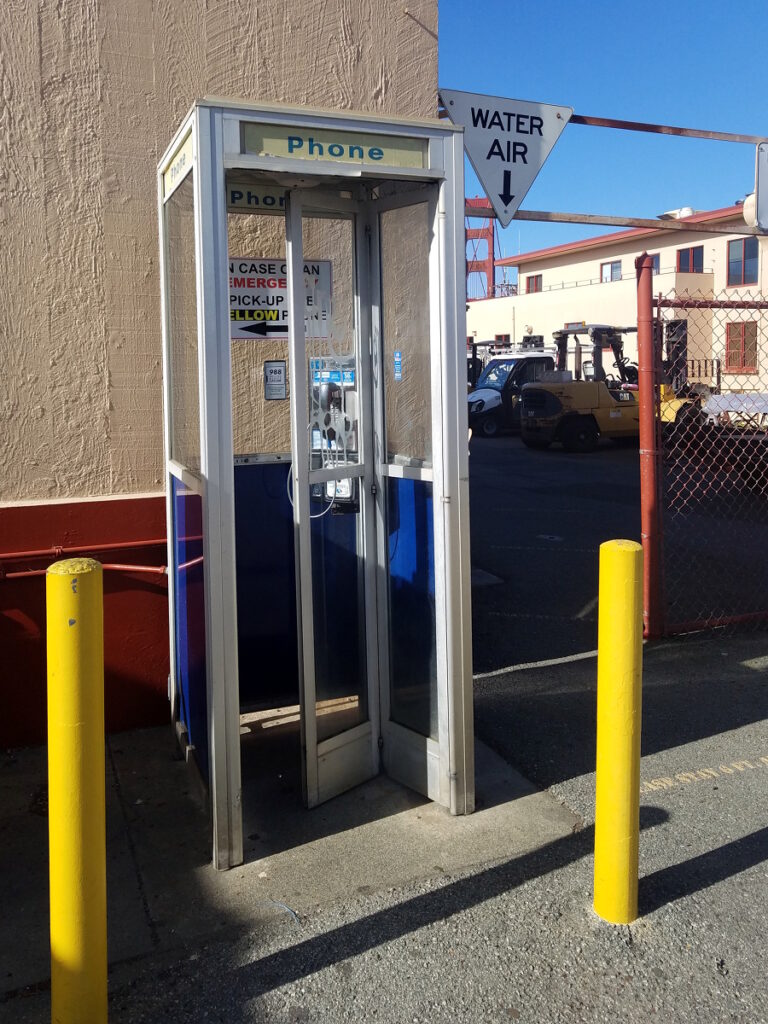
Up the hill behind the bridge, the wind was especially strong and very noisy. Without an external mic or a good wind screen, I was ready to give up. Yet just as I’d round a corner or step into the lee of a building, the bridge’s song would suddenly burst through the wind, so I made a couple more attempts.
Here’s the view and the sound from in front of the first group of portable buildings to the west, where I was able to stand just a little out of the wind (which was blasting out from the left in this picture):
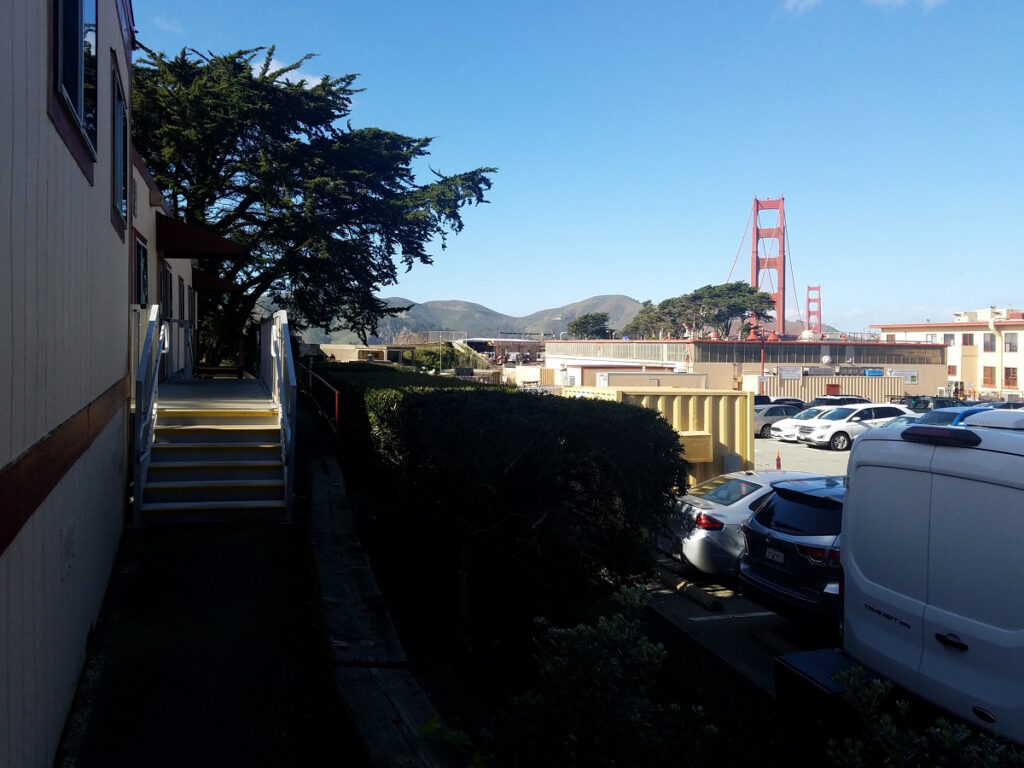
There are some particularly nice “fluting” tones beginning around 1′ 20″.
As I walked a little further up the hill to retrieve the car, the bridge’s song once again overcame the wind so I stopped again and gave it one last shot. It’s not much of a recording. But I did gain some insight into where old GGB Engineering Department maintenance carts go to die:
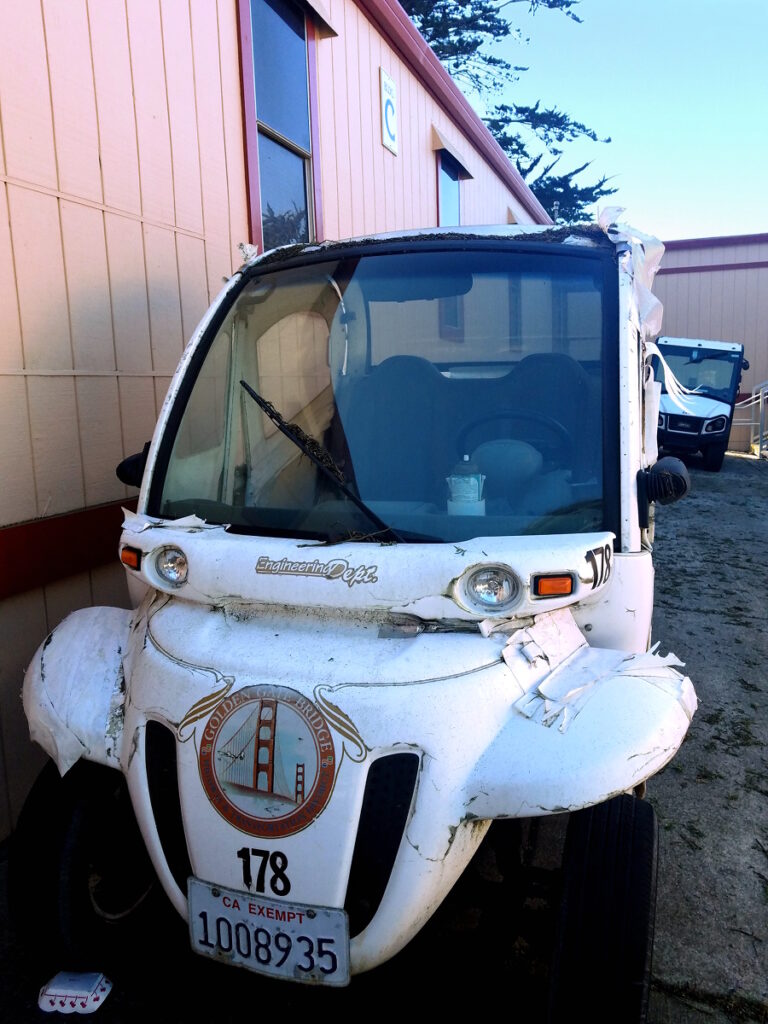
I’m fairly certain the In-n-Out Burger fry tray under the right front tire is not intended as a chock.
Conditions on the ground February 21, 2023
Wind speeds at the Golden Gate itself are not well documented publicly, but the San Francisco Airport reported winds that day of up to 49 mph with gusts up to 68:
WIND (MPH)
RESULTANT WIND SPEED 25 RESULTANT WIND DIRECTION W (290)
HIGHEST WIND SPEED 49 HIGHEST WIND DIRECTION W (290)
HIGHEST GUST SPEED 68 HIGHEST GUST DIRECTION W (280)
AVERAGE WIND SPEED 25.6
This is interesting in light of the details in the District’s published analysis:
“The clip design was tested further in a wind tunnel under 110 different combinations of wind speed and direction, where it was shown to eliminate or make inaudible the sounds in all but two very specific and severe wind scenarios. Those conditions include wind speeds between 36-45mph with an angle of 40 degrees, which would create a high-frequency tone. The other wind combination created a low-frequency sound at a wind speed of 63mph with an angle perpendicular to the railing. Conditions that create the high-frequency tone are expected to occur an average of 70 hours per year, while conditions to create the low-frequency tone are expected to occur an average of 18 hours annually.
“Based on study of the ambient sound in residential areas near the Bridge, both tones, should they occur, are likely to be inaudible to barely audible above background noise.”
Work in progress?
Since December 2021, the completion target statement has been updated:
“Installation of the clips and inserts will be performed by Bridge staff as part of their regular maintenance activities. Installation is expected to be completed in the first half of 2023.”
So, what exactly did we hear? Is the bridge “wind clip” retrofit complete, or still in progress? I guess I’ll be going back, with proper gear this time, waiting for those 18- or 70-hour per year severe wind scenarios…
And for those of you still wondering how I made up for lunch, we had a nice Mexican dinner once back in San Jose that evening.


